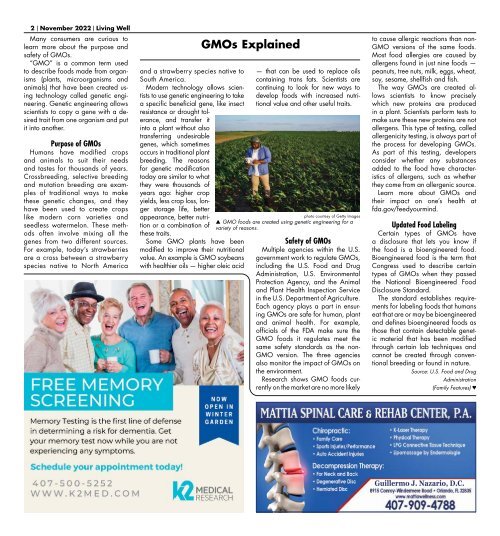110322_SW_Holiday Gift Guide 1 DIGITAL EDITION
You also want an ePaper? Increase the reach of your titles
YUMPU automatically turns print PDFs into web optimized ePapers that Google loves.
2 x November 2022 x Living Well<br />
Many consumers are curious to<br />
learn more about the purpose and<br />
safety of GMOs.<br />
“GMO” is a common term used<br />
to describe foods made from organisms<br />
(plants, microorganisms and<br />
animals) that have been created using<br />
technology called genetic engineering.<br />
Genetic engineering allows<br />
scientists to copy a gene with a desired<br />
trait from one organism and put<br />
it into another.<br />
Purpose of GMOs<br />
Humans have modified crops<br />
and animals to suit their needs<br />
and tastes for thousands of years.<br />
Crossbreeding, selective breeding<br />
and mutation breeding are examples<br />
of traditional ways to make<br />
these genetic changes, and they<br />
have been used to create crops<br />
like modern corn varieties and<br />
seedless watermelon. These methods<br />
often involve mixing all the<br />
genes from two different sources.<br />
For example, today’s strawberries<br />
are a cross between a strawberry<br />
species native to North America<br />
and a strawberry species native to<br />
South America.<br />
Modern technology allows scientists<br />
to use genetic engineering to take<br />
a specific beneficial gene, like insect<br />
resistance or drought tolerance,<br />
and transfer it<br />
into a plant without also<br />
transferring undesirable<br />
genes, which sometimes<br />
occurs in traditional plant<br />
breeding. The reasons<br />
for genetic modification<br />
today are similar to what<br />
they were thousands of<br />
years ago: higher crop<br />
yields, less crop loss, longer<br />
storage life, better<br />
appearance, better nutrition<br />
or a combination of<br />
these traits.<br />
Some GMO plants have been<br />
modified to improve their nutritional<br />
value. An example is GMO soybeans<br />
with healthier oils — higher oleic acid<br />
GMOs Explained<br />
— that can be used to replace oils<br />
containing trans fats. Scientists are<br />
continuing to look for new ways to<br />
develop foods with increased nutritional<br />
value and other useful traits.<br />
photo courtesy of Getty Images<br />
GMO foods are created using genetic engineering for a<br />
variety of reasons.<br />
Safety of GMOs<br />
Multiple agencies within the U.S.<br />
government work to regulate GMOs,<br />
including the U.S. Food and Drug<br />
Administration, U.S. Environmental<br />
Protection Agency, and the Animal<br />
and Plant Health Inspection Service<br />
in the U.S. Department of Agriculture.<br />
Each agency plays a part in ensuring<br />
GMOs are safe for human, plant<br />
and animal health. For example,<br />
officials of the FDA make sure the<br />
GMO foods it regulates meet the<br />
same safety standards as the non-<br />
GMO version. The three agencies<br />
also monitor the impact of GMOs on<br />
the environment.<br />
Research shows GMO foods currently<br />
on the market are no more likely<br />
to cause allergic reactions than non-<br />
GMO versions of the same foods.<br />
Most food allergies are caused by<br />
allergens found in just nine foods —<br />
peanuts, tree nuts, milk, eggs, wheat,<br />
soy, sesame, shellfish and fish.<br />
The way GMOs are created allows<br />
scientists to know precisely<br />
which new proteins are produced<br />
in a plant. Scientists perform tests to<br />
make sure these new proteins are not<br />
allergens. This type of testing, called<br />
allergenicity testing, is always part of<br />
the process for developing GMOs.<br />
As part of this testing, developers<br />
consider whether any substances<br />
added to the food have characteristics<br />
of allergens, such as whether<br />
they come from an allergenic source.<br />
Learn more about GMOs and<br />
their impact on one’s health at<br />
fda.gov/feedyourmind.<br />
Updated Food Labeling<br />
Certain types of GMOs have<br />
a disclosure that lets you know if<br />
the food is a bioengineered food.<br />
Bioengineered food is the term that<br />
Congress used to describe certain<br />
types of GMOs when they passed<br />
the National Bioengineered Food<br />
Disclosure Standard.<br />
The standard establishes requirements<br />
for labeling foods that humans<br />
eat that are or may be bioengineered<br />
and defines bioengineered foods as<br />
those that contain detectable genetic<br />
material that has been modified<br />
through certain lab techniques and<br />
cannot be created through conventional<br />
breeding or found in nature.<br />
Source: U.S. Food and Drug<br />
Administration<br />
(Family Features) ª<br />
Guillermo J. Nazario, D.C.
















